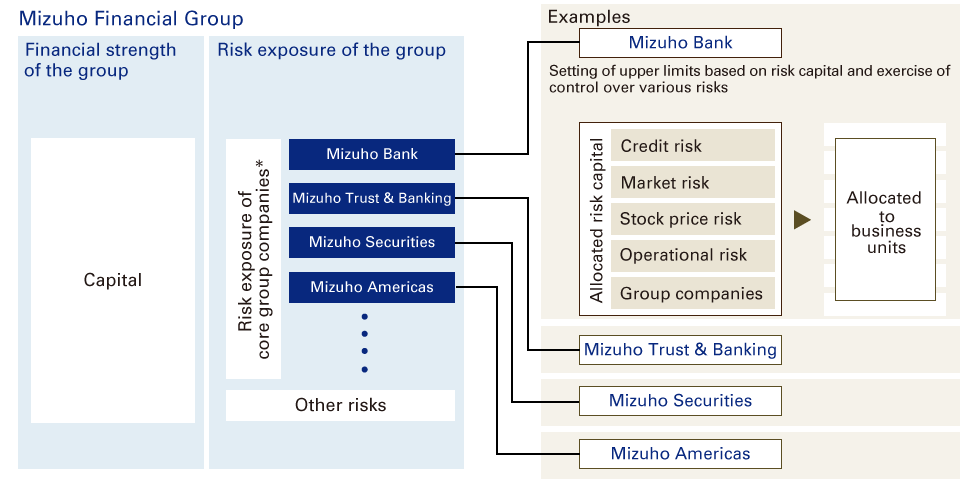Comprehensive Risk Management
Comprehensive Risk Management Systems
At Mizuho, under the basic approach to the implementation of our RAF, we maintain a comprehensive risk management structure ascertaining and assessing overall risk and restricting risk to within a range that is permissible for business.
Under the comprehensive risk management structure, we classify and manage the risks that arise in our businesses according to the various kinds of risk, including credit risk, market risk, liquidity risk, and operational risk. Moreover, our group companies manage risk appropriately according to the nature of their risk, such as settlement risk, trust banking operations risk, and similar. When considering the adoption of new products and services, we check predetermined specific criteria relating to the characteristics of each risk, and institute countermeasures as required.
We have also put in place a system whereby each Mizuho Financial Group company conducts risk management appropriate for the company's business operations and scope and status of risk, and Mizuho Financial Group, as the holding company, oversees risk management across the whole group.
The Risk Management Committee chaired by the Group Chief Risk Officer (Group CRO), which meets monthly, provides integrated monitoring and management of the overall risk for the Mizuho group. The Group CRO reports the risk management situation to the Board of Directors, the Risk Committee, and the Executive Management Committee regularly and as necessary. In addition, Mizuho Financial Group receives reports and applications for approval concerning the risk management situation from our core group companies* and gives them appropriate instructions concerning risk management as necessary.
* Mizuho Bank, Mizuho Trust & Banking, Mizuho Securities, Mizuho Research & Technologies, Asset Management One, Mizuho Innovation Frontier, Mizuho Americas, Custody Bank of Japan, MI Digital Services, and Mizuho Leasing.
Risk Capital Allocation
At Mizuho, under the risk capital allocation framework, we endeavor to obtain a clear grasp of the group’s overall risk exposure and implement measures to make sure this exposure is within limits that are acceptable.
More specifically, we allocate risk capital to our core group companies (including their subsidiaries) to control risk within the limits set for each company. We also control risk within acceptable limits by working to ensure that the overall risk on a consolidated basis does not exceed our financial capacity. To ensure the ongoing financial soundness of Mizuho Financial Group and our core group companies we regularly monitor as necessary the manner in which risk capital is being used in order to obtain an accurate grasp of the risk profile within this framework. Reports are also submitted to the board of directors and other committees of each company. Risk capital is allocated to Mizuho Bank, Mizuho Trust & Banking, Mizuho Securities, and Mizuho Americas by risk category, and is further allocated within their respective business units.
Framework for allocating risk capital

*Includes the risk exposure of group companies that are managed by core group companies